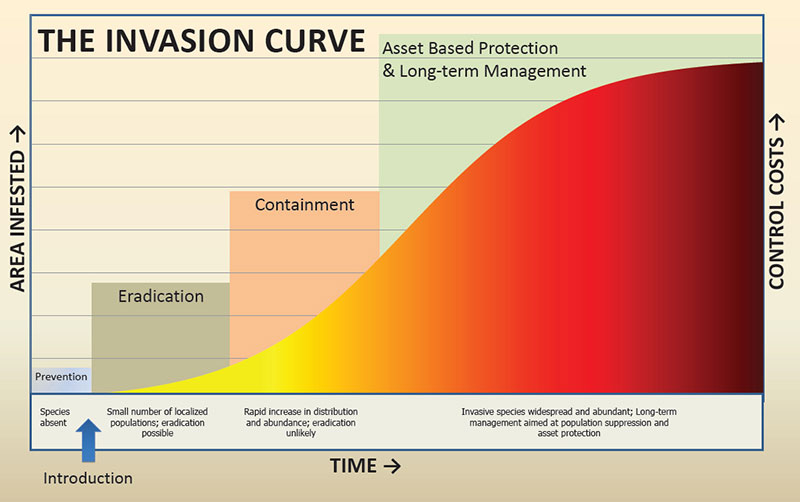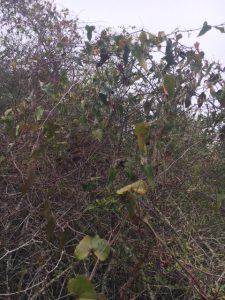The name lets you know that these are probably not good. What we call the Dirty Dozen are those invasive species who are in the high part of the invasive species curve. The section to the right that is red. They are widespread and abundant. They are here and not going anywhere. We are not going to get rid of them. Which brings us back to our first article, why bother then?
Here is analogy that many of you may relate to. There is a native green vine with thorns that grows in the Florida panhandle known as green briar (Smilax). It can be a horrible plant. Vines growing everywhere, thorns tearing at your skin and cutting your clothes. I have seen it growing next to my house literally overtake a large pine tree. It grows over shrubbery, landscape lattice, just a real pain. We do not like it. I cannot get rid of it, it is here to stay, so – why don’t I just walk away and let it grow?
Well, we know what will happen. It will overtake our landscape a create a ball of briars and thorns. I ran into such a place while hiking on Pensacola Beach recently. It was absolute hell trying to get through and I will always walk around such a mess again. Yes… we will manage it in our yard. We will not let it go. And so goes the Dirty Dozen. We should not ignore.
The Dirty Dozen are the top 12 problematic established invasive species within the Six Rivers CISMA selected by its members. A lot of species could be on the list, but the members felt they were having the toughest time with these twelve. Let’s meet them… (these are in no particular order).
- Callery (Bradford) Pear. Yes… this was listed as an EDRR yesterday. I am not sure where this fits. It is either a large EDRR issue, or a small Dirty Dozen (D-12) problem. There are 174 records of this plant in the Florida panhandle and most records come from the Blackwater Forest area. I think this is because they have an aggressive invasive species management program and do an excellent job reporting. It is probably quite common everywhere.
- Chinese Privet. Interestingly, in my mind, this is a north Florida problem. During my travels in south Florida, I never see it, but along I-10 you see it everywhere. It is sort of our Brazilian pepper (a major south Florida problem). And it is everywhere. There are very few places, urban or natural areas, where I have not seen it. Many may not even know what it is.
- Chinese Tallow. This is the famous popcorn tree and yes, its everywhere. One thing I have noticed about this plant is that it seems to move into disturbed areas. Along roadsides and trails, housing developments and agricultural lands. I have seen one grove take over a retention pond, this plant does not seem to have a problem with wetland habitats. This is also the one that beekeepers say make great honey. It is toxic to livestock and wildlife.
- Cogongrass. This invasive plant appears to have entered the U.S. on pallets entering the Port of Mobile. It quickly spread from there across south Alabama, Mississippi, and covers much of Florida. It is easily transported by mowing vehicles that try and mow it down. Many land managers have now learned this and have adopted better practices. It has leaves with serrated edges and silica. Livestock and wildlife do not eat it. It is considered a federal noxious weed and one of the worst invasive species we deal with by many land managers and biologists.
- Feral Hogs. Wild pigs, or feral hogs, are a problem. They destroy large tracks of habitats digging for food. They are very resilient to management efforts and are a real problem for private and public landowners.
- Japanese Climbing Fern. This is the north Florida cousin to south Florida’s Old World Climbing Fern. Both are bad news completely overtaking the landscape as green briar does. Managing it is difficult and it spreads easily by spores. Sometimes managing it can enhance its dispersal.
- Japanese Honeysuckle. My experience with this plant is that it is not as abundant as Japanese Climbing Fern, but where it is found it is aggressive and most be managed.
- Kudzu. Enough said… This could be the poster child (and often is) for invasive species problems. It is a much larger problem in Alabama and Georgia, but north Florida certainly has its problems with it. Like so many of these D-12, it is difficult to manage.
- Mimosa. I grew up with this tree in our landscape and had no idea it was (a) nonnative and (b) an invasive plant. It falls into that category of invasive species that is pretty and people enjoy having it in their landscape. The problem associated with it is that it out competes native species. There is the threat of decrease biodiversity and so, it is listed as invasive. For those trying to manage it in our area, they consider it one of the D-12.
- Red Fire Ant. No one likes this creature. Well, maybe Dr. E.O. Wilson did, but everyone else does not like this animal. We are all too familiar with how aggressive this animal can be and how painful their bites are. They can be found in a variety of landscapes and spread quickly. Their impacts are huge and, as many of you probably know, their management difficult.
- Red Lionfish. This is one that most know about now. This has been reported as being one of the worst invasions of all invasive species ever. Producing an average of 30,000 fertilized eggs/female/week and the fact that they can live to depths of 1000 feet makes management very difficult. However, there has been some success in depths less than 200 feet, and, like all D-12 species, you just have to keep at it. Don’t let the “green briar” overtake.
- Those who know this grass know how hard it is to manage and how quickly it spreads. The team with Gulf Islands National Seashore has been battling it for awhile now. It likes to grow along the waters edge and can be submerged for a short period of time. Those who do not know it, may have it along their waterfront.
Again, these are invasive species we let get to point where management is almost a full-time job and the cost of doing so it quite high. This is why it is so important to manage the EDRR species and avoid this problem. It begins with education of the issue, which we hope you are getting.
Tomorrow is the last day of NISAW 2022, and we will finish with a discussion on what you can do to help manage this problem.
- Our Environment: Part 10 – Improving Agriculture - June 20, 2025
- Marine Creatures of the Northern Gulf – Snails and Slugs - June 20, 2025
- Our Environment: Part 9 – Agriculture Challenges - June 6, 2025


